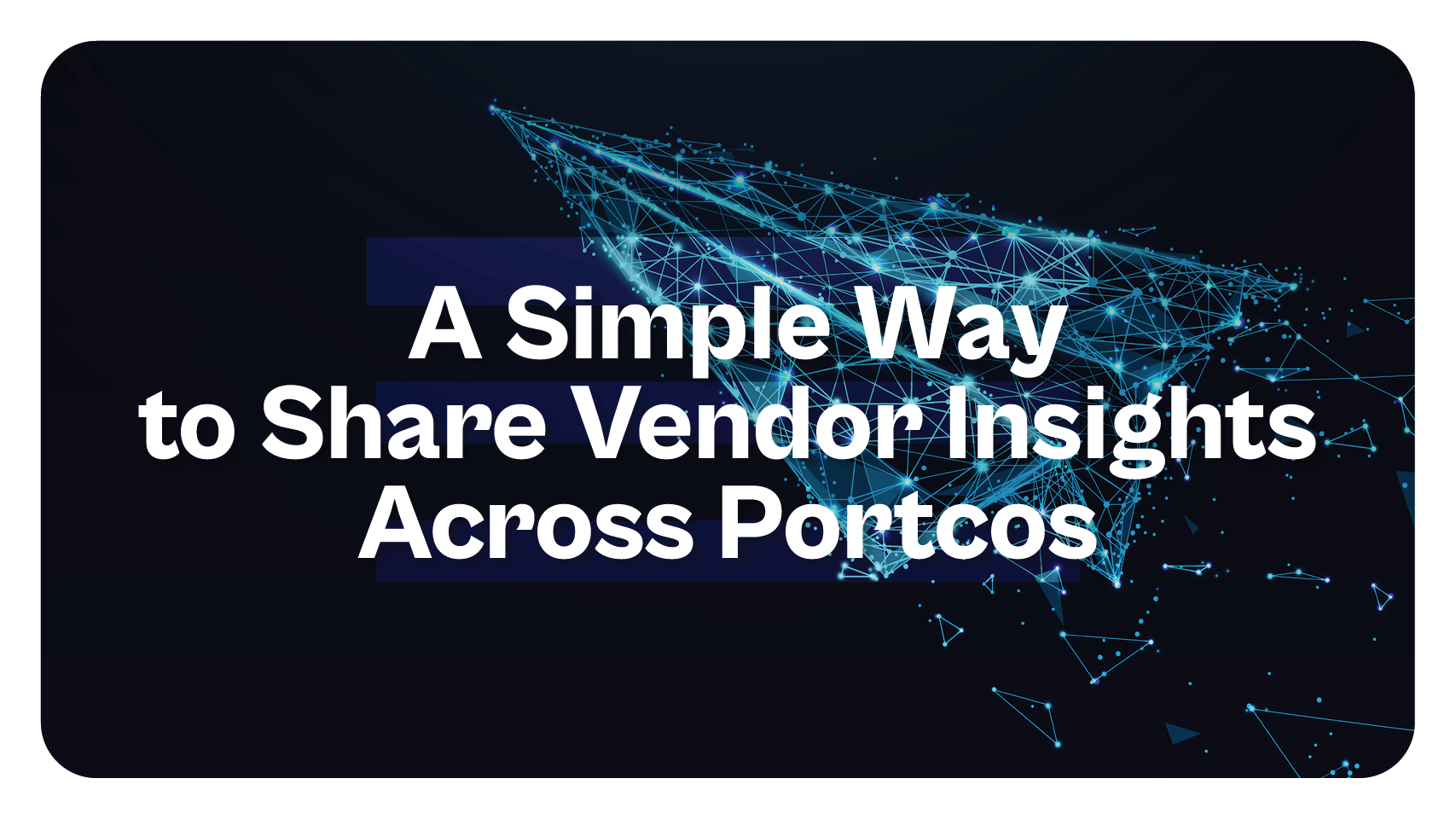
Vendor Management for Portfolio Companies: 10 Must-Have Features

Vendor management isn’t just a line item—it’s a lever. For VC and PE platform leaders, it’s one of the clearest paths to driving operational efficiency, leveraging cost-saving opportunities, reducing risk, and unlocking value across an entire portfolio.
Yet, in many portfolios, vendor relationships are scattered. Processes are inconsistent, oversight is minimal, and valuable savings slip through the cracks. Each company may be negotiating on its own, with little visibility into what’s working—or what’s not.
This is where platform teams can step in and change the game. By introducing structured vendor management solutions for VC platform teams and PE portfolios, leaders can support smarter vendor selection, create repeatable processes, and help their companies make better decisions faster.
It’s not just about procurement—it’s about performance.
The Unique Vendor Management Challenges in PE/VC Portfolios
Managing vendors across a portfolio is a fundamentally different challenge than managing them inside a single company. Each portco has its own needs, tools, budgets, and ways of working. Without structure, it becomes nearly impossible to compare performance metrics or create economies of scale.
Many still rely on spreadsheets, email threads, manual processes, or informal referrals to manage vendors. That might work in the early days—but as portfolios grow, so do the risks. Overspending, underperformance, compliance issues, potential vendor risks—they all compound without a clear system in place.
For platform leaders, this lack of visibility is a missed opportunity. With the best vendor management software, you can streamline vendor onboarding and management, bring discipline to selection and tracking, and turn a historically messy process into a source of strategic leverage.
The Case for Standardized Vendor Management Solutions
For most PE and VC portfolios, vendor management is fragmented by default. Each company handles procurement its own way—choosing vendors, negotiating contracts, and managing relationships in isolation. While this may feel efficient in the short term, it creates long-term blind spots: limited visibility, inconsistent pricing, and uneven performance tracking.
Standardizing vendor management practices across a portfolio changes that. With a central platform and shared process, platform leaders gain real oversight—what vendors are being used, how they’re performing, where the risks lie, and where the opportunities are. It also unlocks negotiation power that individual portcos can’t achieve on their own.
Clients that adopt a more centralized approach have already begun seeing the upside. Some have reported hundreds of thousands in cost savings through smarter vendor selection and consolidation—especially when duplicative or underperforming vendors are replaced with vetted, high-impact alternatives. Others have used centralization to improve compliance monitoring and assurance and reduce manual work across finance, legal, and operations.
Ultimately, it’s about scalability. As portfolios grow, the old way of managing vendors doesn’t hold up. A standardized vendor management solution gives platform teams the structure to scale smarter—supporting each company while keeping a firm-wide pulse on performance, spend, and risk.
A Real-World Scenario: What Standardized Vendor Management Looks Like in Action
Let’s take a common situation: a mid-market private equity firm with 15 portfolio companies, ranging from Series B SaaS startups to mature healthcare providers. The platform team is lean—just three operators supporting finance, HR, and IT functions across the portfolio.
Historically, each portco has managed its own vendors—different software tools, different MSPs, and different contract terms. No shared visibility, no leveraged buying power, and no consistent tracking of performance or spend. No centralized vendor information management.
The platform team decides to pilot a vendor management system with five companies. Within 60 days, they identify overlapping vendors in cloud hosting, outsourced HR services, and cybersecurity. They renegotiate two contracts at the platform level and share internal reviews that help another company avoid a vendor that had performance issues.
Instead of chasing spreadsheets or emailing for recommendations, each company now logs into a shared cloud-based vendor management platform to browse through a pre-vetted vendor network, track contract timelines, and access peer reviews—all backed by data.
The result?
Fewer missed savings opportunities, faster vendor decisions, and a repeatable process that can scale across the portfolio.
Looking to see how much you can save your portfolio companies? Check out our savings calculator!

Top 10 Must-Have Features in Vendor Management Software for Platform Teams
1. Ease of Onboarding
Fast, frictionless onboarding is non-negotiable—especially when rolling out a tool across multiple portfolio companies with varying levels of operational maturity. A strong vendor management platform should offer an intuitive interface, minimal training requirements, and built-in support that helps teams get value from day one. Streamlined vendor onboarding should also be considered.
Look for platforms that offer user-friendly design, clear navigation, and comprehensive training resources like video tutorials, onboarding guides, and interactive demos. Bonus points if the vendor hosts live workshops or Q&A sessions to help users ramp quickly.
Many platform teams start with a small pilot group to test onboarding before a broader rollout. That’s a smart move—and a good way to gauge how easily your companies will adopt the tool.

2. Seamless Communication
In the fast-moving world of vendor selection and management, communication gaps lead to delays, misalignment, and missed opportunities. The best vendor management solutions centralize all communications—so nothing gets lost in email threads or Slack messages. This makes managing vendor relationships simpler and more efficient.
Look for platforms with built-in messaging, real-time collaboration tools, document sharing, and automated alerts. These features keep internal teams and vendors aligned, speed up decision-making, and ensure critical updates never fall through the cracks.
Audit trails and version control are risk mitigation features that help maintain accountability and compliance across contracts, vendor payments, and more. And for global teams, localization and multilingual support ensure everyone stays in sync, no matter where they’re working.
3. Intuitive and Visually Appealing Design
Design matters—especially when a tool is being used across a wide range of companies, roles, and technical abilities. The last thing you want is more clutter in your vendor management process. A clean, intuitive interface reduces friction and increases engagement.
Great platforms use clear visual hierarchy, consistent layouts, and responsive design to make navigation effortless. Interactive elements like drag-and-drop tools or visual dashboards help users engage more deeply, while personalization options (like color themes or layout preferences) improve usability.
Accessibility also counts. Features like keyboard navigation, screen reader compatibility, and strong color contrast help ensure all users—regardless of ability—can access and benefit from the platform.
4. Robust Analytics and Tracking
To make better vendor decisions, platform teams need data—not just anecdotes. Analytics capabilities are essential for tracking vendor performance, understanding engagement across portfolio companies, and surfacing actionable insights.
Look for tools that show who’s using which vendors, how often they’re interacting, and what results those interactions are driving. This kind of transparency helps you identify high-performing vendors, spot trends, and guide smarter decision-making at the company and portfolio level. It also helps maintain vendor relationships by ensuring that all parties are meeting expectations.
When one portco is thriving with a particular vendor, others can follow suit. That’s the power of visibility—and it starts with robust tracking.
5. Powerful Search and Filter Functionality
When your portfolio spans industries, geographies, and stages, finding the right vendor quickly can make or break momentum. That’s why search and filter functionality is a must for strategic sourcing.
Leading platforms allow you to search by category, location, industry, client history, and more—so each company can zero in on vendors that actually fit their unique needs. Subcategories help narrow results, while location filters support regional compliance or preference for local partners.
It’s not just about saving time—it’s about surfacing vendors that are proven, relevant, and capable of delivering value fast.
6. Customizable Dashboards and Reporting
One-size-fits-all reporting rarely works for platform leaders managing a diverse portfolio. Customizable dashboards and reporting tools are essential for surfacing the insights that matter most to each stakeholder—whether it’s tracking vendor performance, monitoring spend, or surfacing compliance trends.
The best vendor management solutions allow users to personalize dashboards with the KPIs and metrics most relevant to their goals. Whether you want high-level overviews or deep dives into vendor-specific data, customizable visuals like charts, graphs, and tables help make insights actionable.
Reporting flexibility is equally important. You should be able to generate custom reports filtered by vendor, portfolio company, category, or time frame—and export that data for internal analysis or board reporting. When paired with real-time monitoring, these tools become a strategic asset for both identifying risks and spotting opportunities across the portfolio.
7. Contract Management Capabilities
Managing vendor contracts across dozens of companies can quickly become chaotic without a centralized system. That’s why built-in contract management capabilities are a must-have.
The right platform helps streamline the entire contract lifecycle—from drafting and negotiation to execution and renewal. Look for features like customizable templates, collaborative editing, redlining, and integrated communication tools to make negotiations more efficient.
Perhaps most critically, automated alerts for upcoming renewals or compliance deadlines help ensure nothing falls through the cracks. A centralized contract repository with version control and audit trails also makes it easier to stay compliant, mitigate risk, and respond quickly to any legal or operational questions. This is the cornerstone of effective risk management.
For platform teams, this isn’t just about organization—it’s about protecting value and reducing exposure at scale.
8. Seamless Integration
Vendor management tools shouldn’t exist in a silo. The most effective solutions integrate smoothly with your existing systems—ERP, CRM, accounting, procurement, and more—creating a connected tech stack that increases accuracy and reduces manual effort.
Integration eliminates duplicate data entry, ensures consistency across platforms, and keeps vendor data up to date everywhere it matters. It also helps portfolio companies maximize the ROI of the systems they already use by enhancing, rather than replacing, those tools.
When evaluating a platform, ask how easily it integrates with the systems your portcos already rely on. True integration isn’t just technical—it’s operational. And it can dramatically improve the day-to-day efficiency of vendor-related workflows across your portfolio.
9. Scalability and Flexibility
Your portfolio won’t look the same a year from now—and your vendor management platform shouldn’t hold you back. Scalability is key for supporting growth across companies, sectors, and geographies. Supplier relationship management shouldn't be a growing pain as your companies grow, too.
Whether you’re onboarding new portcos, entering new markets, or expanding your vendor ecosystem, the platform should adapt. That includes support for multi-language and multi-currency environments, flexible permission structures, and the ability to handle more users, vendors, and workflows without breaking down.
Flexibility is just as important. Can the system evolve with your strategic priorities? Can you add new modules or integrate additional tools as your needs change? A scalable solution grows with your portfolio—not against it.
10. Internal Social Proof
One of the most powerful, yet often overlooked, features in a vendor management system is internal social proof. This means giving your companies visibility into which vendors are already being used—and trusted—by other startups or teams in the portfolio.
This kind of internal evaluation of supplier performance can be invaluable, especially for earlier-stage companies. Seeing that a peer company is successfully using a vendor builds confidence, shortens the evaluation cycle, and reduces perceived risk. It’s the same network effect that drives consumer buying decisions—applied strategically to B2B procurement.
This feature also fosters a culture of knowledge sharing across the portfolio. Companies can learn from each other’s vendor choices, share tips, and even negotiate better deals together. It turns vendor management into a collaborative, value-creating activity across your ecosystem.
Conclusion:
For VC and PE platform leaders, supplier management isn’t just an operational task—it’s a strategic lever for portfolio-wide impact. From improving cost efficiency to increasing transparency, improving risk assessment, and reducing risk itself, the right vendor management system empowers you to lead with clarity and scale with confidence across your companies' procurement processes.
At Proven, we’ve built a vendor management platform designed specifically for the unique challenges of portfolio companies. Whether you're helping early-stage startups make smarter vendor choices or driving standardization across a global portfolio, our platform gives you the visibility, control, and collaboration tools you need to deliver measurable value.
Download the pdf "Quick Reference for Platform Leaders: 10 Must-Have Vendor Management Features"
Next Steps for Platform Leaders
- Audit current vendor tools across your portfolio
- Identify overlaps, redundancies, and blind spots
- Shortlist 1–2 solutions for pilot testing
- Try Proven For Free to see how it fits your operating playbook







.png)





